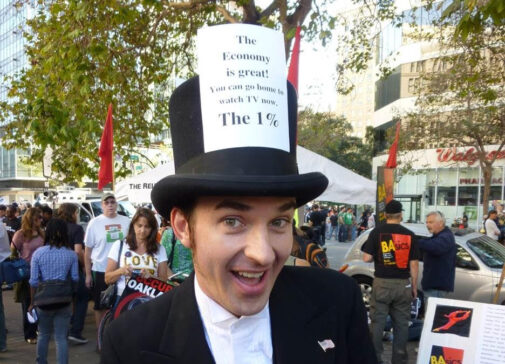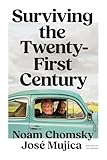 “The economy is great! You can go home to watch TV now. The 1%,” Oakland Occupy satire, November 2, 2011.
“The economy is great! You can go home to watch TV now. The 1%,” Oakland Occupy satire, November 2, 2011.
Like the proverbial spark that ignited a prairie fire, the Occupy movement that began on September 17, 2011, in New York City went viral. Rallying around the slogan, “We are the 99%,” the movement initially mobilized large numbers of what might be called the newly dispossessed. They were looking for remedies to a neoliberal order which was not working for them.
Elements of this same constituency of the dispossessed today are in the Trump camp in part due to the failure of the Democrats to embrace and address their issues. Trump, if there is any upside, presents an opportunity to organize against an increasingly exposed imperial/neoliberal order. Popular protests are called for on April 5. But will they speak to the causes and not just the symptoms, repeating the mistakes of the Occupy movement?
Occupy swept the nation
At its peak in fall 2011, hundreds of thousands participated in Occupy rallies, marches, and encampments across the US.
By early October 2011, Occupy reached the San Francisco Bay Area, where I participated. On October 5, a rally was held at the Federal Reserve Building in San Francisco. Just five days later, protesters demonstrated at Oscar Grant Plaza (so renamed by the protesters after a Black victim of police violence) in Oakland, soon to become an epicenter of militance.
As a handmade sign under the “official” tree of Oakland declared: “An oak tree is just a little nut that decided to hold its ground.”
By October 25, Iraq War veteran Scott Olsen was injured by police at a demonstration in Oakland, generating more publicity and support for the movement. A massive “general strike” on November 2 brought out tens of thousands and temporarily shut down the huge Port of Oakland.
 The children’s brigade calls for a general strike, Oakland Occupy.
The children’s brigade calls for a general strike, Oakland Occupy.
Baby boomer leftists, such as myself, were beside ourselves. It looked like the glory days of the anti-Vietnam War movement had returned. We had seen a temporary resurgence of anti-system sentiment eight years before with opposition to the Iraq War runup. Back then, on February 15, 2003, we had marched in the largest international anti-war demonstration in history.
When that supposed apostle of hope Barack Obama replaced George W. Bush, the latter’s secretary of war Robert Gates continued and so did the Iraq War. Overnight, the Democrats became the party of war, and the peace movement dissipated. But we’re getting ahead of the story.
Returning to the euphoria of the early Occupy Days, I went to rallies and chatted people up. What I discovered was that very few of the newly mobilized had ever been in an anti-Iraq War demonstration, let alone marched against the US military in Vietnam. This younger cohort did not even identify with the former protest movements. But they were angry.
These were folks who were under- or unemployed. Who had lost their homes, their jobs, or their health insurance. They had dependents they could not care for.
And they were resentful. The signs proliferated: “Banks get bailed out, we get sold out.” Or “Trickledown economics is a fancy way for to describe the rich pissing on the poor.” In short, “the system is not broken, it’s fixed.”
While the rich and privileged – the so-called 1% – were the main target of this upwelling of mass antipathy, other culprits were identified. In my mixing with the multitudes, I also heard another undercurrent. This was resentment of immigrants, expressed not only by middle-income Anglos but by people of color of lesser means, including immigrants themselves.
The genius of the Trump phenomenon is that it has been able to opportunistically scapegoat anti-immigrant resentment, thereby assuming the mantle of populism. At the same time, ironies of ironies, the reactionaries are represented by literally the 1% of the 1% in the form of Elon Musk.
Eclipse of Occupy
Failing to address the concerns of the dispossessed, Occupy faded into a historical footnote in less than one year. The anarchist-infused zeitgeist of Occupy was both its great strength and its ultimate fatal flaw. Horizontal decision-making and consensus-based assemblies were appealing and, initially, the participatory spaces filled.
The innovative call-and-response “mic-check” amplified voices where sound equipment was banned. However, “mic check” was fetishized. Slow and inefficient, it favored slogans over examination of complex subjects, leading to frustration. Confident speakers with loud voices were privileged. What was meant to be inclusive reinforced subtle exclusions.
In prefiguring the future, Occupy became untethered from the immediate needs of the present.
Living in a tent camp or even sitting on cold concrete through marathon meetings limited the participatory pool. Folks had jobs they had to go to and dependents to care for.
Most lethal of the deadly faults was avoidance of specific demands. The theory was that making demands of a corrupt system would legitimize that system. Prefiguring the future was counterposed to addressing immediate concerns.
The prevailing mistrust of reforms characterizing the Occupy movement lacked the strategic sophistication of, say, Lenin who explained: “We support every revolutionary movement against the existing order of things… we must work for reforms and use them to prepare for revolution.”
Occupy became plagued by a lack of strategic focus. This refusal to issue concrete demands alienated those dispossessed by the prevailing order who had concrete problems. People, especially those who had never protested before, got disillusioned and drifted away.
Yes, the coercive arm of the state also contributed to the demise of Occupy. But the violent clearance of the encampments, in my experience, came after the tide had ebbed.
The Black Bloc or Antifa (short for anti-fascist) elements, at least in Oakland, also contributed to the expiration of Occupy by driving away supporters who had no interest or ability to militarily skirmish with the police. Occupy’s shunning of designated leaders left the Antifa unaccountable even when the confrontations that they provoked were used as an excuse by the state to shut Occupy down.
Fighting Oligarchy and Hands Off initiatives
With its preoccupation with prefiguring the future, the fundamental failing of Occupy was its inability to address the immediate concerns of the working class. More recently, in the aftermath of the 2024 presidential election, Bernie Sanders gathered attention with a similar observation regarding his political affiliation: “It should come as no great surprise that a Democratic Party which has abandoned working class people would find that the working class has abandoned them.”
This discovery of the class loyalties of the Democrats is correct, though not exactly a revelation to many of us.
Sanders, accompanied by congressmember Alexandria Ocasio-Cortez, has been drawing larger crowds than his previous presidential campaigns on a Fighting Oligarchy tour. This is a positive indication of mass discontent with the slash and burn tactics of the present US administration.
Similar to the earlier Occupy movement, the Fighting Oligarchy tour opposes authoritarianism, in the present case, in the form of Trump. Their focus on the current occupant in the White House, however, suggests that a mere change of personnel is the solution to a far more systematic degeneration.
Like Occupy, they are short on advocating for hard-hitting specifics such as repeal of Taft Hartley, issues that would materially appeal to and benefit working people. Unlike Occupy, they are not in the least bit concerned about cooption. Quite the opposite for this pair, who the Black Agenda Report calls “sheepdogs” for the Democratic Party. Herding disaffected voters back into their party is their mission.
Sanders and Ocasio-Cortez, along with a broad mélange of anti-Trump interests, are organizing for nationwide “Hands Off” protests on April 5. Among the leading groups making the dump-Trump call are MoveOn, Indivisible, and the Working Families Party. These well-funded 501(c)(4) NGOs, while posing as grassroots, are appendages of the Democratic Party, albeit mostly with its “progressive” wing.
The explicitly anti-billionaire initiative accepts funds only from supposedly nice billionaires like George Soros and not nasty ones. An earlier anti-Trump initiative, Families Over Billionaires, also part of the present Hands Off coalition, also received substantial billionaire funding. Their ad hominem critiques of extreme wealth focus on the personal characteristics of the exploiters and not on the neoliberal system (the current form of capitalism) which produces great inequities.
While the Hands Off coalition primarily addresses domestic issues, key among the Democrats’ demands is full reinstatement of military aid to Ukraine. However, waving the Ukrainian flag while suppressing the Palestinian one is not exactly a winning formula for appealing to a polity that just gave the Republicans a trifecta of the White House and both chambers of congress on the (insincere) platform of ending endless wars.
With record low public approval ratings, the Democrats are also promoting restoring USAID regime-change programs. And when they dare murmur a critical comment about Israel, it is about the person of Netanyahu and not about the Zionist enterprise.
Reflecting genuine grassroots peace sentiment, an entirely different coalition will also be in Washington on April 5. The Palestinian Youth Movement, the ANSWER Coalition, Jewish Voice for Peace, and others will be demonstrating against genocide in Palestine and for a US arms embargo of Israel.
The time is ripe to regroup and reorganize a counter movement to the prevailing order. The signs paraded by the Occupy movement are ever relevant today: “Imperialist America is [still] humanity’s number one enemy.”











